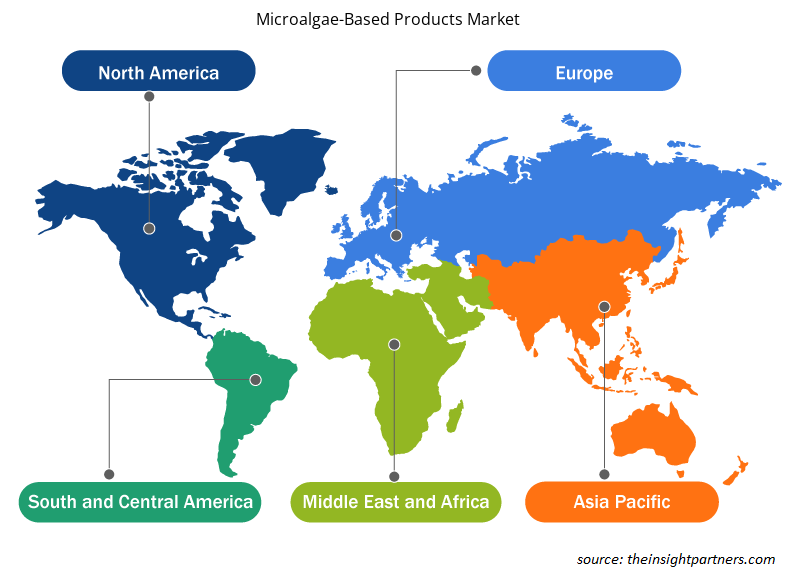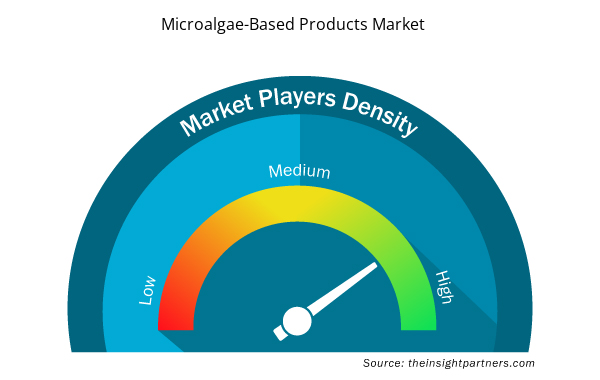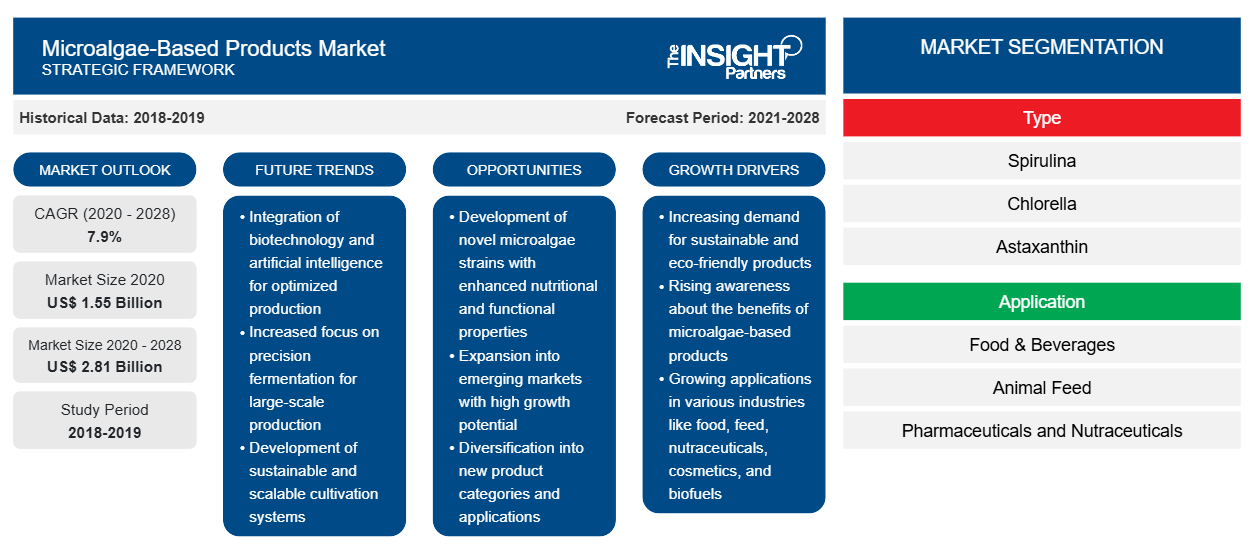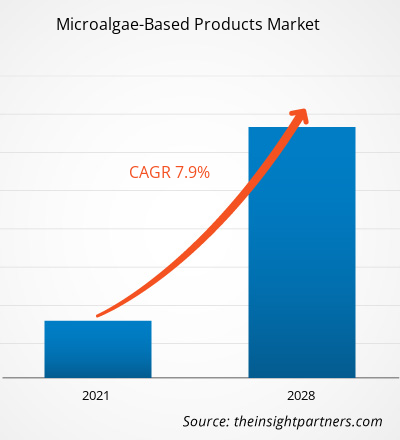2020 年微藻产品市场价值为 15.4723 亿美元,预计到 2028 年将达到 28.111 亿美元;预计 2021 年至 2028 年的复合年增长率为 7.9%。
微藻被定义为可以借助显微镜追踪的原核或真核微生物。这些微生物是单细胞物种,它们单独存在或以链或群体形式存在,可以从淡水和海洋系统中获取。这些微生物具有简单的细胞结构,需要光、二氧化碳、水和磷和氮等必需营养素来生长。此外,微藻是类胡萝卜素、纤维、矿物质、抗氧化剂、脂肪酸、维生素、卤代化合物、多糖、蛋白质和凝集素等重要植物化学物质的来源。微藻被认为是一种有价值的生物质来源,在许多行业中具有多种潜在应用。例如,微藻可用于各种终端用途行业,如食品和饮料、动物营养、药品和保健品以及个人护理。
2020 年,欧洲在全球微藻产品市场中占据最大份额。该地区微藻产品市场的主导地位主要归因于强大的工业基础,包括知名的药品和营养品以及包装食品和饮料制造商。食品和饮料、动物饲料、药品和营养品、个人护理、化学品和生物燃料等各种应用对微藻产品的需求旺盛,推动了欧洲市场的增长。对种植技术的投资不断增加,以及对可持续解决方案的日益关注,为该地区微藻产品市场的增长提供了丰厚的机会。
定制此报告以满足您的需求
您可以免费定制任何报告,包括本报告的部分内容、国家级分析、Excel 数据包,以及为初创企业和大学提供优惠和折扣
- 获取此报告的关键市场趋势。这个免费样品将包括数据分析,从市场趋势到估计和预测。
COVID-19 疫情对微藻产品市场的影响
持续的疫情彻底改变了食品和饮料行业的现状,并对微藻产品市场的增长产生了负面影响。为防止病毒传播而采取的措施加剧了形势,影响了多个工业部门的增长。由于国内和国际边界突然关闭,运营效率突然扭曲,价值链中断,市场受到了影响。由于无限期封锁和旅行限制,从供应商采购原材料中断,制造基地暂时关闭,影响了疫情期间市场的增长。然而,疫情在影响供应链运营的同时,也使消费者的注意力转向了健康生活,因此,消费者将注意力转向了营养食品。此外,食品和饮料、药品和营养品、动物饲料和其他行业对微藻产品的需求不断增长,加上知名制造商的大量投资,预计将推动微藻产品市场的发展。除此之外,微藻在治疗 COVID-19 大流行方面已被证实有多种应用。例如,Frontiers Media SA 于 2020 年 11 月发表的一项研究表明,从微藻中提取的生物活性代谢物在治疗 SARS-CoV-2 类病毒感染方面有效。
市场洞察
制药和保健食品领域对微藻的需求不断增长
微藻基产品已获得公认安全 (GRAS) 状态,使其适用于制药和营养品应用。微藻以其抗菌、抗氧化、抗病毒、抗疟疾、抗真菌、抗肿瘤和抗炎活性而闻名。它们是类胡萝卜素、纤维、矿物质、抗氧化剂、脂肪酸、维生素、卤化物、多糖、凝集素和其他蛋白质等重要植物化学物质的来源。例如,微藻中存在的多不饱和脂肪酸 (PUFA) 是潜在的治疗剂,还可以最大限度地降低心血管疾病、糖尿病、阿尔茨海默病和视网膜问题等慢性疾病的风险。同样,蓝藻(蓝绿藻)越来越多地用于合成抗生素和药理活性化合物。同样,蓝藻(蓝绿藻)的用途已扩展到抗生素和药理活性化合物的制备。此外,一些研究表明,服用小球藻片对治疗恶心、呕吐和其他胃肠道问题非常重要。同样,红藻中的角叉菜胶有助于治疗流感病毒。此外,藻类被认为是具有药理活性的天然产物和保健食品的重要来源。从不同藻类变体中提取的天然产物可作为药物发现的基础,并可用于药物配方。微藻在保健食品行业的潜在应用也已得到确定。目前,从藻类生物质中提取的保健食品在市场上的价值非常高。微藻可广泛应用于食品补充剂、膳食补充剂和增值加工食品以及片剂和软胶囊等非食品补充剂的制备。例如,从小球藻、杜氏藻、红球藻、螺旋藻和束丝藻中获得的微藻广泛用于制备营养补充剂。因此,制药和营养保健品应用基础对微藻的需求不断增加。
类型洞察
根据类型,微藻产品市场细分为螺旋藻、小球藻、虾青素、β-胡萝卜素等。2020 年,螺旋藻占据了全球微藻产品市场的主导地位。螺旋藻被定义为原核蓝藻,其制造用于水产养殖、药品和营养品以及食用染料等多种应用基础。微藻由 60-70% 的蛋白质组成,包括亮氨酸、异亮氨酸和缬氨酸等氨基酸,以及其他必需矿物质,如β-胡萝卜素、B 族维生素、藻蓝蛋白、叶绿素和维生素 E。藻类提供的营养成分使其成为用于各种应用基础的理想成分。螺旋藻被归类为超级食品,被广泛养殖以满足不同终端用途行业不断增长的需求。
应用程序洞察
根据应用,微藻产品市场细分为食品和饮料、动物饲料、药品和营养品、个人护理等。药品和营养品部分在 2020 年占据了最大的市场份额。微藻被认为是药物化合物的可再生来源之一,被归类为公认安全 (GRAS) 状态化合物,非常适合用于制药行业。微藻在抗癌药物——一种名为 cryptophyci 的化合物的配制中被广泛使用。此外,由于它们具有抗炎和抗癌特性,它们还用于制造生物碱神经毒素,如石房蛤毒素和聚酮化合物。同样,小球藻、杜氏藻、红球藻、螺旋藻和束丝藻等微藻被广泛用于配制营养补充剂。
微藻产品市场的主要参与者包括 Algae Health Sciences - A BGG company、Cargill Inc.、Cellana Inc. 和 Cyanotech Corporation。主要公司实施并购和研发战略,以扩大客户群并在全球微藻产品市场中获得市场份额,这将使他们能够扩大品牌影响力。
报告亮点
- 微藻产品市场的渐进式行业趋势可帮助参与者制定有效的长期战略
- 发达市场和发展中市场采用的业务增长战略
- 2019 年至 2028 年微藻产品市场定量分析
- 全球对微藻产品的需求估计
- PEST 分析可说明行业内买家和供应商的效率
- 了解竞争市场状况的最新发展
- 市场趋势和前景以及推动和抑制微藻产品市场增长的因素
- 通过强调支撑商业利益的市场策略来协助决策过程,从而促进市场增长
- 不同节点的微藻产品市场规模
- 市场详细概述和细分,以及微藻产品行业动态
- 各地区微藻产品市场规模及增长潜力巨大
根据类型,全球微藻产品市场细分为螺旋藻、小球藻、虾青素、β-胡萝卜素等。
根据应用,全球微藻产品市场细分为食品和饮料、动物饲料、药品和营养保健品、个人护理等。
微藻类产品市场区域洞察
Insight Partners 的分析师已详尽解释了预测期内影响微藻产品市场的区域趋势和因素。本节还讨论了北美、欧洲、亚太地区、中东和非洲以及南美和中美洲的微藻产品市场细分和地理分布。

- 获取微藻类产品市场的区域特定数据
微藻产品市场报告范围
| 报告属性 | 细节 |
|---|---|
| 2020 年市场规模 | 15.5亿美元 |
| 2028 年市场规模 | 28.1亿美元 |
| 全球复合年增长率(2020 - 2028) | 7.9% |
| 史料 | 2018-2019 |
| 预测期 | 2021-2028 |
| 涵盖的领域 | 按类型
|
| 覆盖地区和国家 | 北美
|
| 市场领导者和主要公司简介 |
|
微藻类产品市场参与者密度:了解其对业务动态的影响
微藻类产品市场正在快速增长,这得益于终端用户需求的不断增长,这些需求源于消费者偏好的不断变化、技术进步以及对产品优势的认识不断提高等因素。随着需求的增加,企业正在扩大其产品范围,进行创新以满足消费者的需求,并利用新兴趋势,从而进一步推动市场增长。
市场参与者密度是指在特定市场或行业内运营的企业或公司的分布情况。它表明在给定市场空间中,相对于其规模或总市场价值,有多少竞争对手(市场参与者)存在。
在微藻产品市场运营的主要公司有:
- 藻类健康科学 - Bgg 公司
- 阿斯塔雷尔公司
- 蓝生物技术国际有限公司
- 嘉吉公司
- Cellana 公司
免责声明:上面列出的公司没有按照任何特定顺序排列。

- 获取微藻类产品市场顶级关键参与者概述
公司简介
- 藻类健康科学 - BGG 旗下公司
- 蓝生物技术国际有限公司
- 嘉吉公司
- 塞拉纳公司
- Earthrise Nutritionals, Llc
- EID - 帕里(印度)有限公司
- 氰基技术公司
- 裸藻株式会社
- 远东生物科技股份有限公司
- 艾斯塔瑞尔
- 历史分析(2 年)、基准年、预测(7 年)及复合年增长率
- PEST 和 SWOT 分析
- 市场规模价值/数量 - 全球、区域、国家
- 行业和竞争格局
- Excel 数据集


- Investor ESG Software Market
- Intradermal Injection Market
- Semiconductor Metrology and Inspection Market
- Sleep Apnea Diagnostics Market
- Portable Power Station Market
- Artificial Intelligence in Defense Market
- Mesotherapy Market
- Point of Care Diagnostics Market
- Wind Turbine Composites Market
- Europe Surety Market

Report Coverage
Revenue forecast, Company Analysis, Industry landscape, Growth factors, and Trends

Segment Covered
This text is related
to segments covered.

Regional Scope
North America, Europe, Asia Pacific, Middle East & Africa, South & Central America

Country Scope
This text is related
to country scope.
常见问题
Microalgae-based products market are expected to witness significant growth in the coming years. Many countries across the globe are increasing their investments in the R&D of microalgae in order to explore the commercial viability of its various applications. Growing requirements to meet the food demand is another factor expected to influence the microalgae-based products market growth in the future. It provides much better yield with lower land requirements, in comparison to other food sources. Biofuels derived through microalgae are also witnessing interest from various parts of the world. Increasing awareness about the climate crisis has led to the rise in demand for cleaner sources of fuel, food as well as to reform the practices that have a negative impact on the environment. Such factors would aid the growth of the microalgae-based products market in the coming years.
Asia Pacific region accounts for a significant share of the global population and the rising disposable incomes and urbanization have increased the demand for new types of food products in the region. Moreover, the emerging economies such as China and India account for a very large share of the Spirulina production. Growing demand for vegan or vegetarian food, have positively contributed to the growth of the market. Moreover, pharmaceuticals and nutraceuticals have been witnessing a surge in demand in the region over the past few years.
Pharmaceutical and nutraceuticals accounted for a major share of the global demand for microalgae-based products in 2020. Increasing consumption of nutritional supplements has propelled the demand for microalgae-based products market. Busy lifestyles, increasing healthcare costs and the growing awareness of the individual daily nutritional requirement have all aided the growth of the pharmaceuticals and nutraceuticals segment of the global microalgae-based products market.
Spirulina accounted for a significant share of the global microalgae-based products market in 2020. Spirulina is a rich and clean source of protein and has gained significant demand over the last decade. In addition to this, it contains Vitamins B1, B2, B3, Copper and Iron. It is widely used for its antioxidant and anti-inflammatory properties while it also helps regulate cholesterol levels.
The major players operating in the global microalgae-based products market are Algae Health Sciences - A BGG company; Bluebiotech International Gmbh; Cargill, Incorporated; Cellana Inc.; Earthrise Nutritionals, LLC; E.I.D. - Parry (India) Limited; Cyanotech Corporation; Euglena Co., Ltd.; Far East Bio-Tec Co., Ltd; and AstaReal among many others.
Microalgae are unicellular microorganisms that live in saline or freshwater. They are a rich source of vital minerals and they are currently used in various applications such as food products, nutritional supplements, personal care, biofuels and others.
Based, on type, the microalgae-based products market is segmented into Spirulina, Chlorella, Astaxanthin, Beta Carotene, and others. Based on application, the global microalgae-based products market is segmented into food & beverages, animal feed, pharmaceuticals and nutraceuticals, personal care, and others.
Trends and growth analysis reports related to Food and Beverages : READ MORE..
The List of Companies - Microalgae-based Product Market
- Algae Health Sciences - A Bgg Company
- Astareal Ab
- Bluebiotech International Gmbh
- Cargill, Incorporated
- Cellana Inc.
- Cyanotech Corporation
- Earthrise Nutritionals, Llc
- Eid Parry Ltd.
- Euglena Co, Ltd
- Far East Bio-Tec Co., Ltd
The Insight Partners performs research in 4 major stages: Data Collection & Secondary Research, Primary Research, Data Analysis and Data Triangulation & Final Review.
- Data Collection and Secondary Research:
As a market research and consulting firm operating from a decade, we have published and advised several client across the globe. First step for any study will start with an assessment of currently available data and insights from existing reports. Further, historical and current market information is collected from Investor Presentations, Annual Reports, SEC Filings, etc., and other information related to company’s performance and market positioning are gathered from Paid Databases (Factiva, Hoovers, and Reuters) and various other publications available in public domain.
Several associations trade associates, technical forums, institutes, societies and organization are accessed to gain technical as well as market related insights through their publications such as research papers, blogs and press releases related to the studies are referred to get cues about the market. Further, white papers, journals, magazines, and other news articles published in last 3 years are scrutinized and analyzed to understand the current market trends.
- Primary Research:
The primarily interview analysis comprise of data obtained from industry participants interview and answers to survey questions gathered by in-house primary team.
For primary research, interviews are conducted with industry experts/CEOs/Marketing Managers/VPs/Subject Matter Experts from both demand and supply side to get a 360-degree view of the market. The primary team conducts several interviews based on the complexity of the markets to understand the various market trends and dynamics which makes research more credible and precise.
A typical research interview fulfils the following functions:
- Provides first-hand information on the market size, market trends, growth trends, competitive landscape, and outlook
- Validates and strengthens in-house secondary research findings
- Develops the analysis team’s expertise and market understanding
Primary research involves email interactions and telephone interviews for each market, category, segment, and sub-segment across geographies. The participants who typically take part in such a process include, but are not limited to:
- Industry participants: VPs, business development managers, market intelligence managers and national sales managers
- Outside experts: Valuation experts, research analysts and key opinion leaders specializing in the electronics and semiconductor industry.
Below is the breakup of our primary respondents by company, designation, and region:

Once we receive the confirmation from primary research sources or primary respondents, we finalize the base year market estimation and forecast the data as per the macroeconomic and microeconomic factors assessed during data collection.
- Data Analysis:
Once data is validated through both secondary as well as primary respondents, we finalize the market estimations by hypothesis formulation and factor analysis at regional and country level.
- Macro-Economic Factor Analysis:
We analyse macroeconomic indicators such the gross domestic product (GDP), increase in the demand for goods and services across industries, technological advancement, regional economic growth, governmental policies, the influence of COVID-19, PEST analysis, and other aspects. This analysis aids in setting benchmarks for various nations/regions and approximating market splits. Additionally, the general trend of the aforementioned components aid in determining the market's development possibilities.
- Country Level Data:
Various factors that are especially aligned to the country are taken into account to determine the market size for a certain area and country, including the presence of vendors, such as headquarters and offices, the country's GDP, demand patterns, and industry growth. To comprehend the market dynamics for the nation, a number of growth variables, inhibitors, application areas, and current market trends are researched. The aforementioned elements aid in determining the country's overall market's growth potential.
- Company Profile:
The “Table of Contents” is formulated by listing and analyzing more than 25 - 30 companies operating in the market ecosystem across geographies. However, we profile only 10 companies as a standard practice in our syndicate reports. These 10 companies comprise leading, emerging, and regional players. Nonetheless, our analysis is not restricted to the 10 listed companies, we also analyze other companies present in the market to develop a holistic view and understand the prevailing trends. The “Company Profiles” section in the report covers key facts, business description, products & services, financial information, SWOT analysis, and key developments. The financial information presented is extracted from the annual reports and official documents of the publicly listed companies. Upon collecting the information for the sections of respective companies, we verify them via various primary sources and then compile the data in respective company profiles. The company level information helps us in deriving the base number as well as in forecasting the market size.
- Developing Base Number:
Aggregation of sales statistics (2020-2022) and macro-economic factor, and other secondary and primary research insights are utilized to arrive at base number and related market shares for 2022. The data gaps are identified in this step and relevant market data is analyzed, collected from paid primary interviews or databases. On finalizing the base year market size, forecasts are developed on the basis of macro-economic, industry and market growth factors and company level analysis.
- Data Triangulation and Final Review:
The market findings and base year market size calculations are validated from supply as well as demand side. Demand side validations are based on macro-economic factor analysis and benchmarks for respective regions and countries. In case of supply side validations, revenues of major companies are estimated (in case not available) based on industry benchmark, approximate number of employees, product portfolio, and primary interviews revenues are gathered. Further revenue from target product/service segment is assessed to avoid overshooting of market statistics. In case of heavy deviations between supply and demand side values, all thes steps are repeated to achieve synchronization.
We follow an iterative model, wherein we share our research findings with Subject Matter Experts (SME’s) and Key Opinion Leaders (KOLs) until consensus view of the market is not formulated – this model negates any drastic deviation in the opinions of experts. Only validated and universally acceptable research findings are quoted in our reports.
We have important check points that we use to validate our research findings – which we call – data triangulation, where we validate the information, we generate from secondary sources with primary interviews and then we re-validate with our internal data bases and Subject matter experts. This comprehensive model enables us to deliver high quality, reliable data in shortest possible time.


 获取此报告的免费样本
获取此报告的免费样本